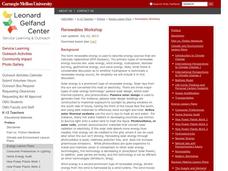Bonneville
Titanium Dioxide Solar Cell Construction and Testing
There's raspberry juice in solar cells!? Scholars create and test a titanium dioxide raspberry solar cell in the seventh of 14 lessons in the Cost Effective Solar Cells unit. They coat glass slides with titanium dioxide to make their...
Bonneville
Introduction to the Photovoltaic Effect
Let a video light the way to a better understanding of solar energy. Scholars first learn vocabulary terms related to the photovoltaic effect, solar cells, and electricity. They then watch a video to learn why silicon is often used as a...
Bonneville
Copper Oxide Solar Cell Construction and Testing
Who knew some pieces of copper and some saltwater would be enough to generate electricity? The fifth of 14 lessons in the Cost Effective Solar Cells unit challenges scholars to create a solar cell. They take two copper sheets, use a hot...
Bonneville
Solar Panel Basics
Going outside is a logical step when dealing with solar panels. Future scientists learn about the n-type and p-type layers of solar cells in the third of 14 lessons in the Cost Effective Solar Cells unit. They go outside to model the...
Bonneville
Solar Cell Manufacturing Field Trip and/or Guest Speaker
Appreciate the chance to get out of the classroom. Scholars take a field trip to a solar cell or solar panel facility to learn about the manufacturing aspect of the business. They also hear from a guest speaker and ask questions about...
Bonneville
Titanium Dioxide Raspberry Solar Cell Data Sharing
Concerned about how well others did on the experiment? Scholars share results from the titanium dioxide raspberry solar cell test they performed in the previous lesson. After analyzing the data, they come up with a claim about the...
Space Awareness
Climate Zones
The climate at the equator is hotter than the climate at the poles, but why? The lesson plan goes in depth, explaining how the angles of illumination relate to the heating rate at different latitudes and seasons. Scholars use a strong...
Bonneville
Solar Energy Equity and Sustainability
Generate some knowledge about generating electricity. Pupils first read several articles to learn about solar energy, its advantages and disadvantages, and advancements in technology related to solar cells. They then have a class...
Bonneville
Solar Panel Data Sharing
It's important to share—especially in science. Pupils share the data on voltage, current, and resistance they recorded when they built circuits with solar cells in a previous instructional activity. They discuss the results with the...
Teach Engineering
Concentrated Solar Power
The seventh segment in an eight-part unit promotes the idea of concentrating the sun to increase the power of a photovoltaic panel. Pupils learn about devices used such as reflectors or lenses.
Teach Engineering
Maximum Power Point
Investigate the maximum power output of a photovoltaic panel with a lesson that introduces the class to the maximum power point. Individuals learn how to determine the maximum power point of a solar panel by using Ohm's law and the power...
Teach Engineering
The Temperature Effect
How temperature affects the efficiency of a solar panel is the focus of the third in a series of eight resources that presents how engineers are able to control the temperatures of photovoltaic panels. Class members find out how the...
Teach Engineering
Solar Angles and Tracking Systems
The sun will continue to rise in the east and set in the west, no matter what. The first lesson in a series of eight introduces the class to solar angles. It makes connections between a person's latitude and the angle of position of the...
Science Geek
Electrochemistry
Introduce redox reactions including how to identify and solve them. After reviewing the rules for assigning oxidation numbers, a presentation presents trends and vocabulary. Finally, it explains voltaic cells, electrolytic cells,...
Bonneville
Engaging with Solar Panels
Build a fan and become a fan of solar power. The second of 14 lessons in the Cost Effective Solar Cells unit has learners first construct circuits with solar cells to power a fan, a motor, and an LED. They then test their circuits both...
National Energy Education Development Project
Introduction to Solar Energy
People have been using solar energy for many generations to dry crops, heat homes, and for light. This presentation explains how now it is possible to capture the solar energy and store it for future use, details how and where people use...
Magic of Physics
Solar Panel
Solar panels are everywhere! How do they work? Energize the class with an interactive that explains the magic of solar energy. The simple click-through demonstration shows how photons are captured and converted to a usable source of...
Bonneville
Can Portable PV Charge Vehicles?
Take charge of learning about electric vehicles. Instructors first provide the class with information about PV modules and batteries. Learners then conduct an experiment where they connect PV modules in series and in parallel to...
Bonneville
Designing a Solar Charger
The sun can even charge batteries. The fourth of five lessons in the Solar Transportation unit has pupils design a charger that uses solar modules to charge a 12-volt lead-acid battery. They estimate the charge that accumulates and...
Bonneville
Electrical Energy and Solar Module Efficiency
It's much more efficient if everyone knows the relevant terms. Pupils research vocabulary terms related to electric currents to start a unit on solar energy. They then use a multimeter to measure the voltage and current for a solar...
Carnegie Mellon University
Renewables Workshop
Youngsters examine resource maps to find out which states are using solar and wind power and discuss as a class various other renewable energy sources. They use a provided data table to record pros and cons to each technology, build and...
Other popular searches
- Chlorophyl Solar Cells
- Chlorophyll Solar Cells
- Photosynthesis Solar Cells
- Solar Cells for Satellites
















